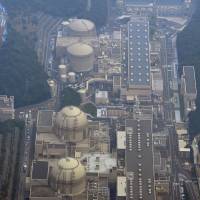The Osaka High Court rejected an appeal Friday by Kansai-area citizens who were seeking an injunction to prevent the restart of the Oi No. 3 and 4 reactors in Fukui Prefecture.
Some 253 residents opposed the restart of the two reactors on safety grounds, warning that a method the utility used to calculate ground motion during an earthquake underplayed the danger. They sought an immediate court order to prevent a restart.
The Oi reactors, which were restarted in July 2012 — the first in the country to resume after the March 11, 2011, quake and tsunami that devastated the Tohoku region and the Fukushima No. 1 nuclear plant — have been idle since last autumn. The units have to meet new safety standards set by the Nuclear Regulation Authority that took effect last summer. The Osaka High Court ruled that as the Oi plants are still undergoing the inspections, no rush for an injunction is needed.
"Unless it's clear the situation is one of imminent restart of the reactors, we can't say that there is credible evidence for the necessity of issuing an injunction for preventing their restart," the court ruled.
The plaintiffs argued that safety could not be guaranteed as Kansai Electric Power Co. has used two different methods to determine potential damage. The first, the Takemura method, determines the tsunami height potential from an earthquake. The second, the Irikura/Miyake method, is used to determine potential seismic motion that would strike the reactor site.
The Takemura method is modeled after past Japanese quakes, taking the average, whereas the Irikura/Miyake model uses — except for one quake in Japan — temblors from around the world, likewise taking the average degree of intensity of the shaking.
The plaintiffs had claimed that, by using two methods, Kepco was underplaying the potential damage to the plants.



